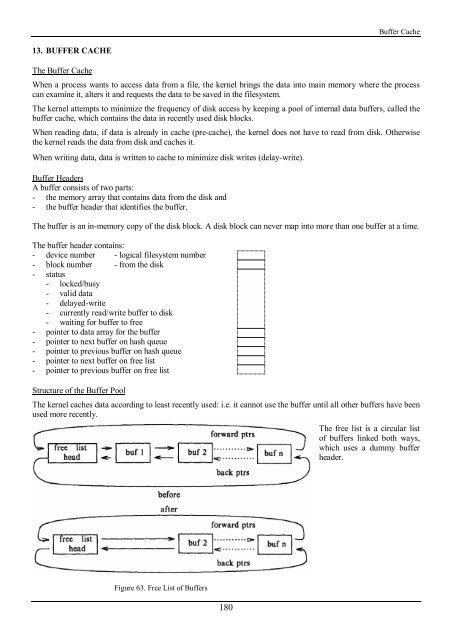You also want an ePaper? Increase the reach of your titles
YUMPU automatically turns print PDFs into web optimized ePapers that Google loves.
Buffer Cache<br />
13. BUFFER CACHE<br />
The Buffer Cache<br />
When a process wants to access data from a file, <strong>the</strong> kernel brings <strong>the</strong> data into main memory where <strong>the</strong> process<br />
can examine it, alters it and requests <strong>the</strong> data to be saved in <strong>the</strong> filesystem.<br />
The kernel attempts to minimize <strong>the</strong> frequency of disk access by keeping a pool of internal data buffers, called <strong>the</strong><br />
buffer cache, which contains <strong>the</strong> data in recently used disk blocks.<br />
When reading data, if data is already in cache (pre-cache), <strong>the</strong> kernel does not have to read from disk. O<strong>the</strong>rwise<br />
<strong>the</strong> kernel reads <strong>the</strong> data from disk and caches it.<br />
When writing data, data is written to cache to minimize disk writes (delay-write).<br />
Buffer Headers<br />
A buffer consists of two parts:<br />
- <strong>the</strong> memory array that contains data from <strong>the</strong> disk and<br />
- <strong>the</strong> buffer header that identifies <strong>the</strong> buffer.<br />
The buffer is an in-memory copy of <strong>the</strong> disk block. A disk block can never map into more than one buffer at a time.<br />
The buffer header contains:<br />
- device number - logical filesystem number<br />
- block number - from <strong>the</strong> disk<br />
- status<br />
- locked/busy<br />
- valid data<br />
- delayed-write<br />
- currently read/write buffer to disk<br />
- waiting for buffer to free<br />
- pointer to data array for <strong>the</strong> buffer<br />
- pointer to next buffer on hash queue<br />
- pointer to previous buffer on hash queue<br />
- pointer to next buffer on free list<br />
- pointer to previous buffer on free list<br />
Structure of <strong>the</strong> Buffer Pool<br />
The kernel caches data according to least recently used: i.e. it cannot use <strong>the</strong> buffer until all o<strong>the</strong>r buffers have been<br />
used more recently.<br />
The free list is a circular list<br />
of buffers linked both ways,<br />
which uses a dummy buffer<br />
header.<br />
Figure 63. Free List of Buffers<br />
180
















